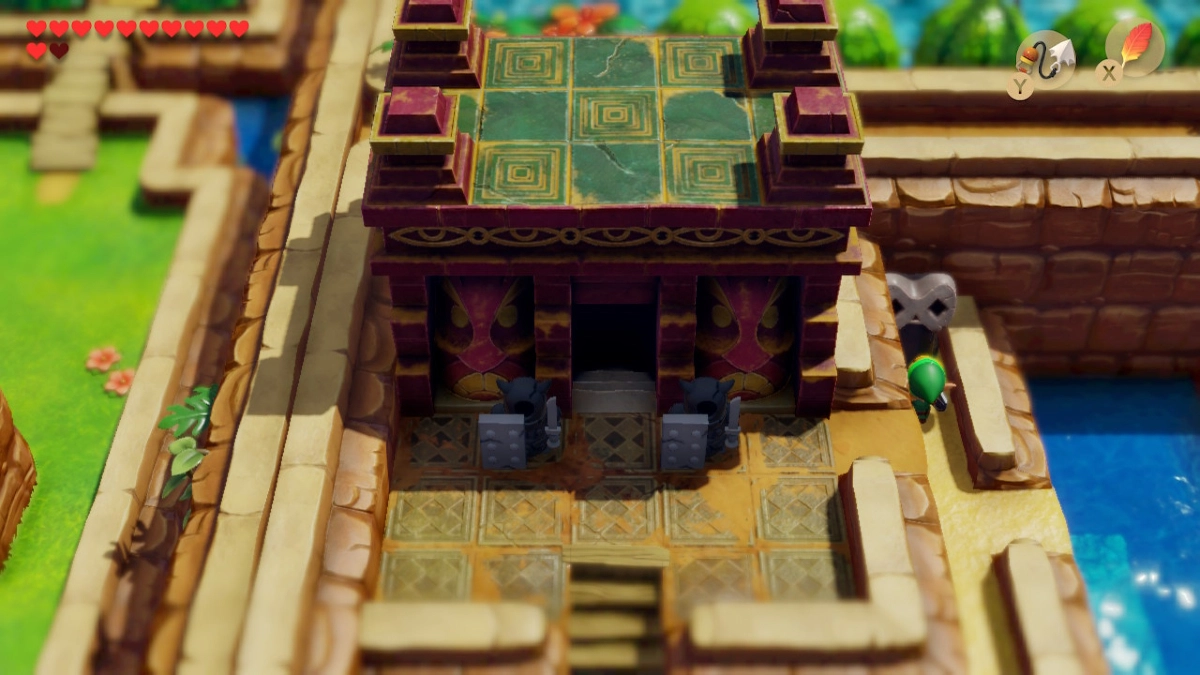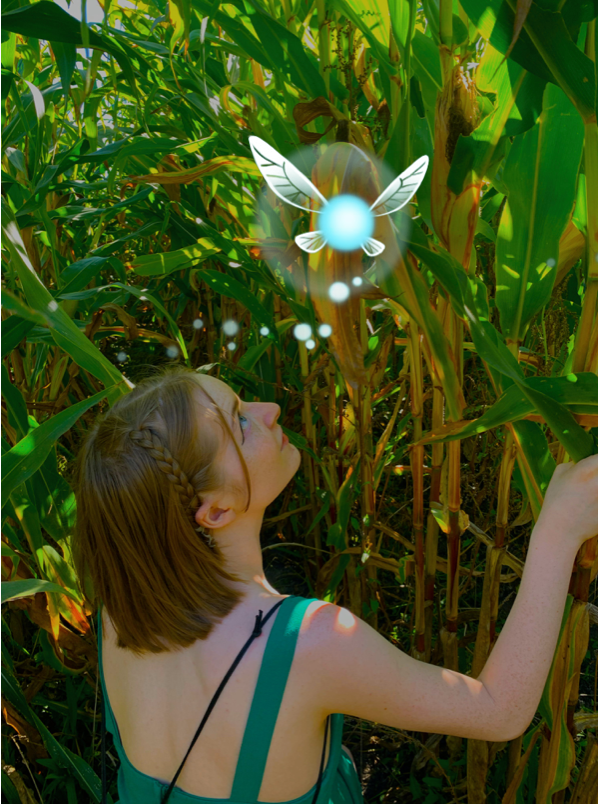The Face Shrine: The Tone Shift That Didn’t Need The Face Lift
Posted on January 26 2023 by Alexandria Weber

The original Link’s Awakening, a game released in 1993 for the Game Boy, had every appearance of being the first happy-go-lucky adventure of the Zelda series. The stalwart loneliness of the 1986 Zelda and the unforgiving bleakness of The Adventure of Link had made the series one of survival; adventure yes, but Hyrule was expansively sporadic as far as a lived-in kingdom. Understandably due to the constraints of technology, it wasn’t until 1991 that Hyrule felt more substantial. A Link to the Past introduced a castle, a fleshed-out story, a colorful cast of characters, and a land that seemed to jump outside the screen and into our imaginations. It’s a classic for many reasons, and one of them is the undeniable gallantry of a youth who, against all odds, saves the seven maidens, defeats Ganondorf, and rescues Princess Zelda. A Link to the Past, for me at least, is a solid proof of concept for the large-scale storytelling, immersion, and adventure-pulled gameplay that had been experimented on in The Legend of Zelda and The Adventure of Link.
A Link to the Past is filled to the brim with stakes, heroism, and danger. Although released before my time, I can imagine it being the pinnacle of action-adventure video games for the late 80’s and early 90’s. So then why do I prefer Link’s Awakening? The 1993 game about Link being marooned on an island did so much less for the series in the long run and made such a lesser impact in comparison. Yet, Link’s Awakening is higher on my personal ranking list of Zelda games, and a single dungeon tips the scales. I’ll never say that A Link to the Past is a bad game, but one small corner of the overworld changed everything about Link’s Awakening for me. A dark shadow was cast over what seemed to be a silly adventure for the hero Link, and the twist was executed perfectly from day one.
The Lead Up: Southern Face Shrine

Although being stranded on a mysterious island surely wouldn’t be the most comforting situation to find yourself in, Koholint Island is a place that puts players immediately at ease. Link awakens confused in a stranger’s home, yet Tarin and his daughter Marin treat the washed-up hero with kindness and care. Koholint Island is not without its dangers and hazards, but with a sword and shield at the ready, there is never a challenge that seems insurmountable or impossible. The game is charmingly silly, with Mario Bros. references around every corner, eccentric characters, and wacky-looking enemies.
The first five dungeons of Link’s Awakening paint the title as a kooky adventure for the series, a fun take on an otherwise serious repertoire of video games. Like Mario Bros. games, plot is at first thin and simple, the game encouraging you to just play, fight things, and figure out puzzles. A Link to the Past sussed out the format and formula of a Zelda game, and Link’s Awakening is a well-polished and well-established game that continued that success of balancing different moving parts without needing to prove anything. After all, what could be more Zelda-esque than collecting eight instruments to save an innocent and unsuspecting island of people from all these pesky monsters?
After Catfish’s Maw, you collect the Wind Marimba and are vaguely encouraged by an unspecified, otherworldly speaker to head towards a “shrine.” As you head down the path that would lead you towards either of the shrines on the map, the owl that has been guiding you thus far says the following: “Hoot! There are two shrines, one to the north, the other in the south. First, head south, where ancient ruins speak of the Wind Fish. You will learn much there…”
The plaque Link finds at the Southern Face Shrine exposes the true nature of this island, that Koholint is the Wind Fish’s dream, and that all these people, should you decide to end it, will fade from existence as he awakens. This includes all the friendships you’ve forged that seemed so real, including the pretty girl Link has begun to admire. The twist tints this charming island with a far less colorful perspective, and onsets for Link a mindset of mourning, uncertainty, dread, and panic.
Of course, Link at the end of a day is an avatar for the player, but even in 1993, the developers were able to demand you feel certain feelings and emotions. This is due to the physical design of the dungeon itself, the musical choices, and the resulting change of overall tone.
Face Shrine Dungeon Design

The Southern Face Shrine, where you learn about the true nature of the island, already has an architectural symbolism. It consist of three rooms, two of which funneling you straightaway into the third. This alone shows that there is no escape from the truth, nor is there any byway or loophole to avoid it.
The actual dungeon to the north, a maze of ceramic doors and various blue and orange tiles, continues to dwell upon the tragedy of the situation. This shift in Link’s Awakening strikes a balance between dropping the information and letting the game progress as normal, and pushing the reveal too far. The Face Shrine section of the game is a perfect balance of the two, the game letting you discover it on your own and, in the dungeon that follows, process it.
For Link in particular, the information would likely be particularly and understandably difficult, and there are a few visual queues in the dungeon that echo this. The main dungeon item, the L-2 power bracelets, is used primarily to lift large ceramic elephants in order to progress forward. This symbolizes the burden of knowledge, as elephants in many cultures are representative of wisdom. In Japan specifically, the color pink, which is prominent in the Face Shrine, symbolizes happiness and springtime. While it could be a mere coincidence, it would be one of the saddest artistic choices in the series. In defeating Facade and collecting the Coral Triangle, Link is leaving the heavily pink-hued Face Shrine. This decision, the first boss he has killed while knowing the full truth of the island, means that he has firmly decided to leave behind all those wonderful things that this island had provided him. He commits to waking the Wind Fish and leaving behind happiness and the idyllic tropical island that he has come to know.
Facade, the boss of the dungeon that appears as a literal face on the floor, looks back at Link with a grin. Like seeing a reflection of yourself that you don’t want to see, Link must conquer the idea that by making the island disappear, he would be the villain. Thus, the Face Shrine is an entire journey of feeling the weight of information and responsibility, knowing the costs of the decision you are being prompted to make, and overcoming the voice that tells you literally that you are the bad guy.
The Face Shrine is also a good dungeon for more ways than just symbolism. Switching between the orange and blue platforms, though not unique to the Face Shrine or even Link’s Awakening, is done in such a way that it takes advantage of the three-dimensional space. It also makes the dungeon linear only if you know what you are doing, yet confusing enough to present a fair puzzle to first time players. The dungeon makes use of several different items you have acquired thus far in your adventure, and the 2019 version excels in this spectacularly, items assigned to multiple buttons making gameplay smooth.
Playing The Heart Strings Like A Fiddle

It’s a testament to composers Kazumi Totaka, Minako Hamano, and Kozue Ishikawa that Link’s Awakening excelled when it came to music. Over the longevity of the series, it’s easy to point to instances where the chip-tune music of the time did not sound very pleasing to the ears. Notably “Spirit’s Grave” and “Crown Dungeon” from Oracle of Ages are prime examples of a series of disturbing notes being quite off-putting to a gameplay experience. Iconic songs like the original theme from The Legend of Zelda, the credits theme from A Link to the Past, and “Temple Theme” from The Adventure of Link don’t just drop out of the sky. Professionals worked hard to push past the limited things they could do with music in video games at the time to create something long-lasting and magical. Face Shrine and Southern Face Shrine, among many other songs in Link’s Awakening, are among those accomplishments.
The 2019 version of Link’s Awakening added gorgeous, sweeping stringed instruments like the cello and the viola to add to the gravitas of any given musical track. Yet, if it weren’t for the original work on Face Shrine and that sad, lamentative, and mournful way the notes move, we wouldn’t have the masterpiece that exists now. Even in the chip-tune style, Southern Face Shrine presents a simple yet pleading melody with scales that rise incrementally but does so in such a slow manner that it drowns you in the sadness and disillusionment of what Link has discovered. Face Shrine, the dungeon that follows, offers the backing track of what was heard before, but in a slightly lower key, as if it is lingering echoes of the grief in what you’ve learned. This is no trivial thing, the island being a dream, it’s no quick solution chime, no “aha” moment; it’s something to be pondered and kept within you.
The title of this article suggests that the truths exposed in Southern Face Shrine and the dungeon that succeeds it did not need the 2019 remake. This is not to suggest that the 2019 remake did it poorly, ruined it, or even did it in a subpar manner, but to claim that the original did it so well that it didn’t need to be touched. As far as Link’s Awakening goes, I believe they needed to fix things such as the limitations of only two item slots and the way you couldn’t warp to as many places. Those aspects begged for a remake. Face Shrine had already accomplished an emotional resonance that was ahead of its time. Arguably, no Zelda dungeon has ever topped the way this one bleeds with emotion.
That being said, I am extremely glad they did remake the game, because the way technology has expanded made the Southern Face Shrine and Face Shrine music go from heartbreakingly tragic to breathtakingly tragic. The stringed instruments combined with the original chip-tune is, in my opinion, one of the greatest accomplishments in video game musical composition. Hearing the new versions for the first time had me crying, partly because it evoked so much sadness, but also partly because it was just so good.
Conclusion

Link’s Awakening basks in the sadness and mourning for just the right amount of time, yet the rest of the game is never quite the same. Your actions are no longer happenstance or matterless, but they now have a great weight to them. Defeating the bosses of Eagle’s Tower and Turtle Rock feels far different than the silly adventure that you started out on when you were first marooned, and this is not a bad thing at all. It’s the effectiveness of the Face Shrine that shifts the happy, carefree tone to one that is serious and full of responsibility. In some ways, it’s like growing up.
What do you think? What were your initial reactions to the twist in Link’s Awakening? What aspect makes it most effective? Is it as effective as I’ve claimed? Let us know in the comments below!

Alexandria Weber is a Senior Editor and an aspiring creative writer. Her favorite food is apple pie and she loves her cat Galadriel. Ask her for pictures!



